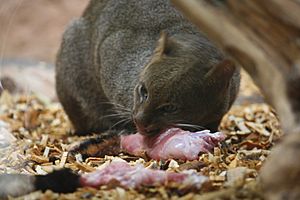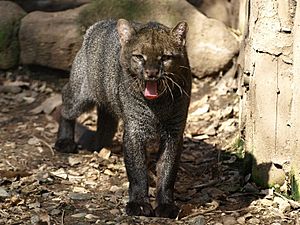Jaguarundi facts for kids
Quick facts for kids Jaguarundi |
|
|---|---|
 |
|
| A jaguarundi at the Pont-Scorff zoo | |
| Conservation status | |
| Scientific classification | |
 |
|
| Where the jaguarundi lives (2015) | |
| Synonyms | |
|
List
Felis yagouaroundi Geoffroy, 1803
Puma yaguaroundi Lacépède, 1809 F. eyra Fischer, 1814 F. unicolor Thraill, 1819 F. cacomitli Berlandier, 1859 F. apache Mearns, 1901 F. fossata Mearns, 1901 F. panamensis Allen, 1904 |
The jaguarundi (Herpailurus yagouaroundi) is a wild cat that lives in the Americas. You can find it from central Argentina all the way up to northern Mexico. It also lives through Central and South America, especially east of the Andes mountains.
This medium-sized cat has a slim body. It comes in two main colors: gray and red. The jaguarundi has a long body, short legs, a small head, and a long tail. It looks a bit like animals such as weasels. It is about twice the size of a domestic cat. It stands nearly 36 centimeters (14 inches) tall at the shoulder. It weighs between 3.5 and 7 kilograms (7.7 to 15.4 pounds).
Jaguarundis are shy and usually live alone or in pairs. Unlike many other wild cats, they are more active during the day. They hunt mostly in the daytime and evening. These cats live in large areas and are spread out. They are good at climbing trees. However, they usually hunt on the ground.
They eat many different animals. Their diet includes ground-feeding birds, reptiles, rodents, and small mammals. Jaguarundis can have babies all year round. After about 70 to 75 days, a mother gives birth to one to four kittens. In zoos, jaguarundis can live up to 15 years.
Jaguarundis live in many different places. These include tropical rainforests, deciduous forests, deserts, and thorny scrublands. They are common in Brazil, Peru, and Venezuela. However, they might be gone from the United States. The jaguarundi is listed as "Least Concern" by the IUCN Red List. But their numbers are going down in many places. This is because their homes are being lost or broken up. People also sometimes harm them for killing chickens.
Contents
About the Jaguarundi Name
The name "jaguarundi" comes from an old language called Old Guarani. The word yaguarundi means "dark jaguar". In some Spanish-speaking countries, people call it gato colorado (red cat) or gato moro (Moorish cat). In Brazilian Portuguese, it can be called eyra or gato-mourisco.
Jaguarundi Family Tree
Scientists first described the jaguarundi in 1803. They gave it the scientific name Felis yagouarundi. Over the years, other scientists found different jaguarundi specimens. They gave them slightly different names. For example, a reddish one from Paraguay was called Felis eyra. A grayish one from Mexico was called F. cacomitli.
In 1858, a scientist named Nikolai Severtzov suggested a new group name, Herpailurus, for the jaguarundi. Later, some scientists put the jaguarundi in the same group as the cougar (Puma concolor). But in 2017, cat experts decided that the jaguarundi should be in its own group, Herpailurus. This means it's the only species in that group.
How Jaguarundis Evolved
The jaguarundi is most closely related to the cougar. These two cats, along with the cheetah, belong to a group called the Puma lineage. This group is one of eight main cat family groups. The Puma lineage split off from other cats about 6.7 million years ago.
Scientists think these three cats might have shared a common ancestor about 8.25 million years ago. The Puma lineage probably traveled from Asia to North America. They crossed a land bridge called the Bering Strait. Then, they moved into South America through the Isthmus of Panama. This happened between 4 and 3 million years ago. The jaguarundi we know today came into existence around 0.5 million years ago.
What Jaguarundis Look Like
The jaguarundi is a medium-sized cat with a slim body. It has one main color all over. This makes it look very different from other cats in its area, like the small, spotted ocelots. The jaguarundi has some features that look like mustelids, such as otters and weasels. It has a long body, short legs, a small, narrow head, and small, round ears. Its nose is short, and its tail is long.
From head to body, it measures between 53 and 77 centimeters (21 to 30 inches). Its strong, muscular tail is 31 to 52 centimeters (12 to 20 inches) long. It's about twice the size of a domestic cat. It stands nearly 36 centimeters (14 inches) tall at the shoulder. It weighs between 3.5 and 7 kilograms (7.7 to 15.4 pounds). Some larger ones have weighed around 9 kilograms (20 pounds). Males are usually a bit bigger than females.
Their fur is mostly one color. They might have a few faint marks on their face and belly. Baby jaguarundis have spots for a short time, which disappear as they grow. There are two main color types: gray and red. The gray ones can be blackish to brownish-gray. The red ones can be foxy red to chestnut. Both colors can be born in the same litter. Red jaguarundis are seen more often in dry, open areas.
Jaguarundis have 30 teeth in total. Their ears are spaced far apart and are about 2.5 to 4 centimeters (1 to 1.6 inches) long. They don't have spots on the back of their ears.
Where Jaguarundis Live
Jaguarundis live in many different places. These include tropical rainforests, deciduous forests, deserts, and thorny scrublands. They can also be found in cloud forests, mangroves, and savannas. Unlike other cats like the ocelot, jaguarundis can live in open areas. In open places, they prefer areas with lots of plants like cacti. These plants make it hard for other animals to get to them.
Jaguarundis usually stay near water. They are known for being able to handle changes in their habitat. They can even do well in areas where forests have grown back. They usually live in lowlands up to 2,000 meters (6,600 feet) above sea level. But they have been seen as high as 3,200 meters (10,500 feet) in Colombia.
Their home range stretches from central Argentina in the south to northern Mexico. This is the second-largest area for any cat, after the cougar. Jaguarundis are quite common in Brazil, Peru, and Venezuela. However, they might no longer live in the United States. The last confirmed sighting in the U.S. was in Texas in 1986.
There have been reports of jaguarundis in Florida since 1907. Some say they were brought there by a writer and released. Jaguarundis were also reported in Alabama in the 1980s.
Jaguarundi Behavior
Jaguarundis are shy and like to keep to themselves. They are very careful around traps. Scientists have studied them using radio trackers in Belize, Brazil, and Mexico. Even though they can be active day and night, they seem to prefer hunting during the day and evening. For example, in Belize, they start moving before sunrise and stay active until sunset. They hunt most actively from late morning to noon. This makes them more active during the day than most other cats.
Jaguarundis can swim across medium-sized rivers. One was seen swimming across the Tuichi River in Bolivia. They are also good climbers. However, they mainly hunt on the ground. Their fur color helps them blend in with their surroundings. They can jump up to 2 meters (6.6 feet) in the air to catch birds. Animals that hunt jaguarundis include boa constrictors, cougars, and domestic dogs.
Jaguarundis are usually seen alone or in pairs. Pairs might be a mother with her older kittens or a male and female during mating season. Jaguarundis in zoos tend to be more social. They live in large home ranges. In Brazil, females had home ranges of 1.4 to 18 square kilometers (0.54 to 6.95 square miles). Males had ranges of 8.5 to 25.3 square kilometers (3.28 to 9.77 square miles).
Jaguarundis use different ways to communicate. They might scratch areas with their hind feet or claw on logs. They also rub their heads on objects. They have many different calls, including chattering, purring, screaming, whistling, and a bird-like chirp.
What Jaguarundis Eat
Jaguarundis mostly eat small animals that weigh less than 1 kilogram (2.2 pounds). This includes ground-feeding birds, reptiles, frogs, insects, rodents, and small mammals. They also eat larger prey like chickens, fish, marmosets, rabbits, and opossums. Sometimes, they might eat small deer (perhaps already dead). They have also been seen eating grasses. Studies show that jaguarundis eat about 400 grams (0.88 pounds) of prey each day. They tend to eat whatever is most common and easiest to catch in their area.
Jaguarundi Reproduction and Life Cycle
Jaguarundis can mate all year round. However, there are times of the year when more mating happens. For example, in Mexico, breeding peaks in January and March. The mother gives birth to one to four kittens in a den. This den might be in a thick bush or a hollow tree.
The kittens are born with fur and spots on their underside. These spots disappear as they get older. Their fur color also changes as they grow. When the kittens are about three weeks old, the mother starts bringing them solid food. But they usually just play with it at first. By about six weeks, kittens can eat solid food like birds and guinea pigs. Jaguarundis become old enough to have their own babies when they are one to three years old. In zoos, they can live up to 15 years.
Threats and Conservation
Since 2002, the jaguarundi has been listed as "Least Concern" on the IUCN Red List. This means it's not in immediate danger of disappearing. The jaguarundi populations in Mexico, except for the northeast, seem to be stable. Large protected areas in the Amazon Basin are important for keeping jaguarundi numbers healthy.
The jaguarundi's fur is not very valuable, so people don't hunt them much for it. However, their biggest threat is losing their habitat. Their homes are being destroyed or broken up. People also sometimes harm them for killing chickens.
Jaguarundi populations in North and Central America are listed in CITES Appendix I. This means they are highly protected. All other populations are listed in CITES Appendix II, which also offers protection. In the US, jaguarundis are protected under the Endangered Species Act. Hunting jaguarundis is restricted in Peru. It is banned in many other countries, including Argentina, Brazil, Colombia, Mexico, and Venezuela.
See also
 In Spanish: Yaguarundí para niños
In Spanish: Yaguarundí para niños







